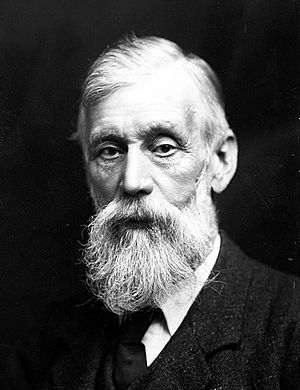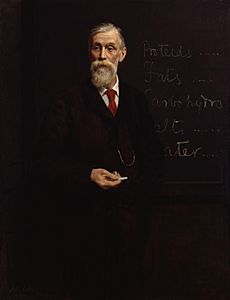Michael Foster (physiologist) facts for kids
Quick facts for kids
Sir Michael Foster
|
|
|---|---|
 |
|
| Born | 8 March 1836 Huntingdon, England
|
| Died | 29 January 1907 (aged 70) London, England
|
| Alma mater | University College School |
| Known for | Textbook of Physiology (1876) |
| Scientific career | |
| Fields | Physiologist |
| Institutions | |
| Academic advisors | |
| Notable students | |
| Influenced | |
Sir Michael Foster (born March 8, 1836 – died January 29, 1907) was an important English scientist. He was a Physiologist, which means he studied how living things work. He helped create the famous biology school at Cambridge University. He also served as a leader for the Royal Society, a group for top scientists.
Contents
Early Life and Education
Foster was born in Huntingdon, England, in March 1836. His father, Michael Foster, was also a medical professional. Young Michael went to Huntingdon Grammar School. He was a good cricket player there, known as a "capital cricketer." He also attended University College School in London.
After finishing his medical studies in 1859, he started working as a doctor in his hometown. But in 1867, he returned to London. He became a teacher of practical physiology at University College London. Two years later, he became a professor there.
A Career in Physiology

In 1870, Trinity College, Cambridge, asked him to teach physiology. Thirteen years later, he became the first professor of physiology at Cambridge University. He held this important position until 1903. One of his most famous students at Cambridge was Charles Scott Sherrington. Sherrington later won the Nobel Prize in 1932.
Foster was an excellent teacher and manager. He played a big part in setting up and growing the biology school at Cambridge. From 1881 to 1903, he was one of the secretaries of the Royal Society. In this role, he greatly influenced the study of biology in Britain. In 1899, he was made a Knight Commander of the Order of the Bath (KCB). He also served as president of the British Association in 1899.
Foster's Writings and Contributions
Sir Michael Foster wrote a very important book called Textbook of Physiology in 1876. This book became a standard guide for studying how the body works. He also wrote Lectures on the History of Physiology during the 16th, 17th and 18th Centuries in 1901. These were based on talks he gave in San Francisco. In 1902, he was chosen to be a member of the American Philosophical Society.
He died suddenly in London in 1907.
Foster's Love for Irises
Beyond his scientific work, Foster also loved plants, especially irises. He even named many new iris species himself. One iris he introduced was Iris lineata.
The iris species Iris fosteriana was named after him in 1881.
The British Iris Society created the Foster Memorial Plaque in 1926. This silver medal has a picture of Foster surrounded by irises. It is given to people who have made important contributions to the study of irises. Early winners included George Yeld, John Caspar Wister, and Séraphin Joseph Mottet. This award is still given out today.
See also
 In Spanish: Michael Foster para niños
In Spanish: Michael Foster para niños

